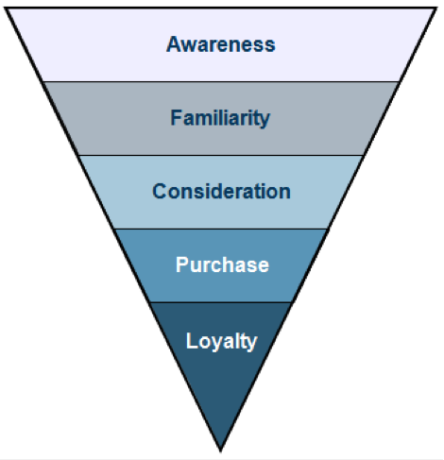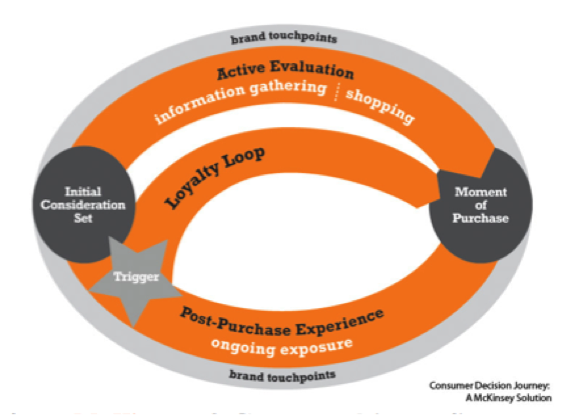We all know the typical structure for campaign build outs. Usually we segment by product type, theme, or category. Our keyword lists are filled to the brim of purchase-intent phrases such as “buy __” or “order ___ online”. This strategy is great and all, but those who are still in the top of the funnel are a bit neglected. With a full-funnel PPC strategy, we can increase our chances of being top of mind when that user decides to make a purchase.
The First Interaction
Let me show you the purchase funnel:

The campaign structures I mention above fit more towards the Consideration and Purchase sections of the funnel, where a user is actively looking to buy. While this is probably effective for many accounts, I think it’s worth at least exploring the idea of creating top of funnel Awareness and Familiarity campaigns.
If you are reading this piece and thinking “Hmm, I wonder if I should consider this strategy for my PPC campaigns?” I suggest taking a look in Google Analytics to see how users are converting. Also take a look at search queries for your existing keywords to see if top of funnel terms are already coming through.

The example above is for an online consignment store. Many queries are like those pictured: people looking for information on where to buy/sell clothing.
Take another look at an ecommerce account:

This account has implemented Top of Funnel (TOF) campaigns, which contain general “seed” keywords. The purpose of these campaigns is to fill the funnel, as well as provide valuable information the user might be looking for as they begin their gardening endeavors.
On the lead generation side of things, the funnel structure might be a good choice if your product or service has a long sales cycle or requires a substantial amount of research before purchase.
For a client that offers free quotes and recommendations for different types of business software, we broke campaigns into two segments: research and consideration. The research campaigns point to more informational pages and whitepapers, while the consideration campaigns are sending users to a lead form. In addition, research campaigns will be used to create remarketing lists via Analytics to draw these users back to the site with very specific messaging.
After The First Touch
TOF campaigns are a great way to build a remarketing strategy, using traditional display remarketing, remarketing for search, or both!
Take this opportunity to have more control over what kinds of messaging users encounter in their 2nd (or 3rd) touch point with your brand. Say you create a remarketing list comprised of users who clicked the campaign “Top of Funnel Product X”. In your remarketing campaign, your ad copy can have specific offers or additional information for Product X.
After the Sale
Now that we’ve spent so much time thinking about pre-purchase behavior, let’s think about what happens after that initial sale or conversion.
Let’s look at another take on the consumer decision journey:

As marketers, we shouldn’t forget about repeat customers. Consider utilizing special ad copy and offers to users who have already purchased, provided you have room in your budget and your overall marketing strategy aligns with this tactic.
If you are selling a product or service that users will likely renew or re-purchase after a certain time frame, use remarketing list cookie windows to your advantage. Start showing ads around the time frame when the user is going to be thinking about purchasing again to warm them up and bring them to your site.
Set Up
Top of Funnel
This is the research stage. Think about what users might be asking Google. This could be about a specific problem – i.e., “what is a good low impact workout” or “best workout machines”. As far as ad copy goes, you’ll want to have a very clear value proposition and messaging that makes it apparent to users that your product is what they need to solve their problem.
Familiarity / Consideration
These users may be a bit more familiar with your brand, and probably have a better idea of what they need. This is where they’ll be comparing different brands, looking at prices, and ultimately deciding what to buy. They might be searching for your brand (or competitor brands) and getting any other questions they have answered. While you may have provided informational content in the top of funnel stage, here you might begin showing product pages with specific keywords and ads.
Benefits
Budget
Segmenting broad, top of funnel research queries into their own campaigns allows for much better budget control.
Fill your Funnel
By advertising (with low bids) on keywords that you would normally add as negatives, you’re allowing users to see your brand name while they are researching. This allows you to grow your funnel for future remarketing purposes.
Keyword Research
Learn how users are searching for your products. This is especially beneficial if you’re using modified broad keywords.
Closing Thoughts
While a funnel structure won’t necessarily work for every account, it might be worth a try if you’ve got a relatively long sales cycle with a product that users research or just generally want more information before purchasing.




